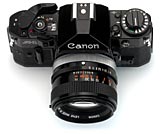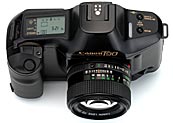Although the design of the A-series lineup including AE-1 and its successor, the A-1, was well-received among users, the Canon camera design department was aware of the limitation in the conventional design method. In automated cameras which no longer require a winding lever or rewinding crank, the mechanical design applied to the A-series cameras would result in something like an empty shell. Design is meaningless without contents. Different contents shall be met with different designs; consequently, the high-tech cameras with advanced technologies deserve their own designs. The camera design department had confidence that they were the ones who could break through the barrier with pride of success achieved in the design of the A-series. The camera design department successively developed design models for the new concept camera, though their activities were not necessarily encouraged within the company. There was already an established design concept for the advanced SLR cameras on the market and half of Canon's overall sales were brought by such camera sales. Against this situation, the camera design department proclaimed its design policy, which worked as the guidelines for the next-generation cameras: "as long as a camera functions as a tool to extend the roles of human hands and eyes for image reproduction, it must be human-friendly." Thus the earliest idea of ergonomic design, which is incorporated commonly to many products nowadays, emerged through the development of the T90. |
| Enhancing the capability of image reproduction requires a camera to be multi-functional, but the camera does not qualify as truly "multifunctional" if its versatile functions make the operation complicated. Look at the Canon A-1 at the right below. The A-1 is the first model which realizes the fully-automated, computerized control with multiple functions. When the A-1 was launched in 1978, it dominated the market with a catch phrase, the "camera robot." “Multifunctional” was directly reflected in its design style deserving its name "robot." Still, there was a room for improvement in terms of easy operation. |

